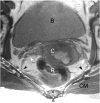Quantitative analysis of uterosacral ligament origin and insertion points by magnetic resonance imaging
- PMID: 14990404
- PMCID: PMC1226709
- DOI: 10.1097/01.AOG.0000113104.22887.cd
Quantitative analysis of uterosacral ligament origin and insertion points by magnetic resonance imaging
Abstract
Objective: To estimate the percentage of healthy women in whom the uterosacral ligaments are identifiable on standard magnetic resonance imaging (MRI) scans and to determine origin points from the genital tract and insertion points on the pelvic sidewall.
Methods: Eighty-two asymptomatic women (mean +/- standard deviation age 53 +/- 12 years; mean parity 2.5, range 0-7) volunteered for this study. They were eligible if the most dependent vaginal wall point lay at least 1 cm above the hymenal ring remnant during a Valsalva maneuver. Axial proton density MRI of the entire pelvis was analyzed at 5-mm intervals. All results were referenced to the ischial spine. We determined the visibility of the uterosacral ligaments and located their origins from the genital tract and their insertion points on the pelvic sidewall.
Results: Uterosacral ligaments were visible in 61 (87%) of 70 analyzable scans. They extended over a mean craniocaudal distance of 21 +/- 8 mm (range 10-50). Three regions of origin were found: cervix alone, cervix and vagina in the same section, and vagina alone. Thirty-three percent, 63%, and 4% of 254 identified origin points were from these three areas, respectively. Of 259 uterosacral insertion points, 82% overlaid the sacrospinous ligament/coccygeus muscle complex, 7% the sacrum, and 11% the piriformis muscle, the sciatic foramen, or the ischial spine. Although uterosacral ligament morphology was similar bilaterally, its craniocaudal extent was greater on the right side.
Conclusion: In healthy women, the uterosacral ligament origin and insertion points exhibited greater anatomic variation than their name would imply.
Figures



References
-
- Olsen AL, Smith VJ, Bergstrom JO, Colling JC, Clark AL. Epidemiology of surgically managed pelvic organ prolapse and urinary incontinence. Obstet Gynecol. 1997;89:501–6. - PubMed
-
- Richardson AC, Lyon JB, Williams NL. A new look at pelvic relaxation. Am J Obstet Gynecol. 1976;126:568–71. - PubMed
-
- Singh K, Jakab M, Reid WM, Berger LA, Hoyte L. Three-dimensional magnetic resonance imaging assessment of levator ani morphologic features in different grades of prolapse. Am J Obstet Gynecol. 2003;188:910–5. - PubMed
-
- Campbell RM. The anatomy and histology of the sacro-uterine ligaments. Am J Obstet Gynecol. 1950;59:1–12. - PubMed
-
- Nichols DH. Types of prolapse. In: Nichols DH, Randall CL, editors. Vaginal surgery. 4th ed. Baltimore (MD): Williams & Wilkins; 1996. p. 101–18.
Publication types
MeSH terms
Grants and funding
LinkOut - more resources
Full Text Sources
Medical

